 Summer ended in a glorious fashion, with warm sunny days and leaves falling from the trees. The children discovered all sorts of interesting insects and other small creatures. There was lots of fun with balls, digging in the sandbox and garden, bike riding, balancing, and playing games with friends.
Summer ended in a glorious fashion, with warm sunny days and leaves falling from the trees. The children discovered all sorts of interesting insects and other small creatures. There was lots of fun with balls, digging in the sandbox and garden, bike riding, balancing, and playing games with friends.



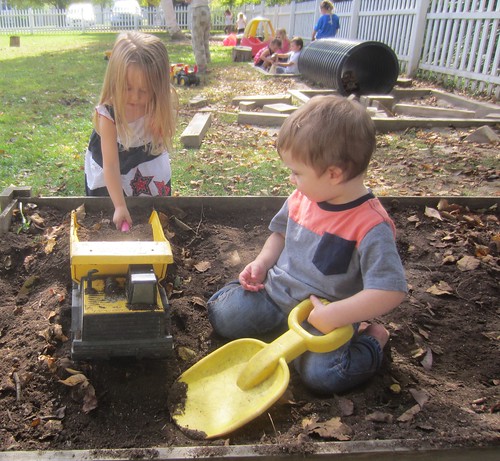

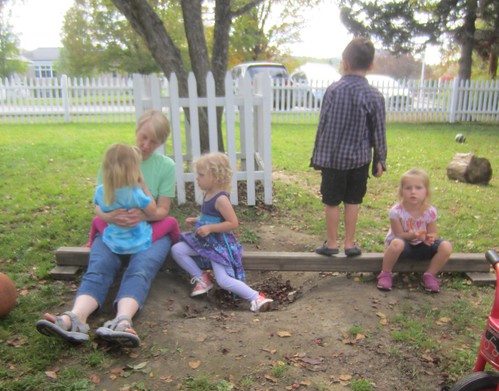




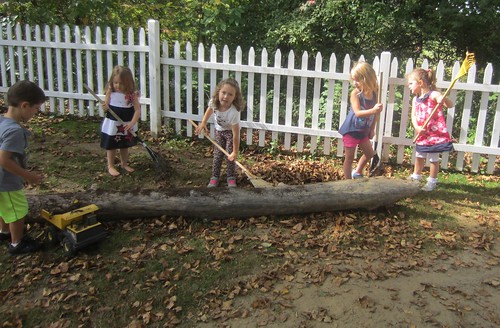






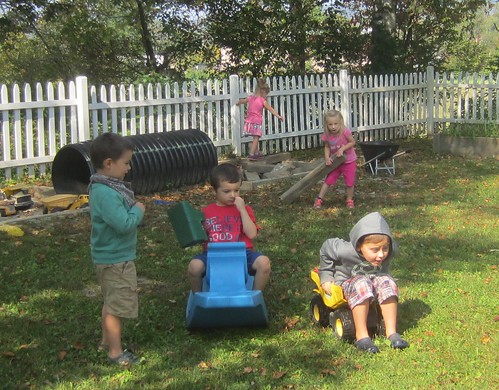

 For Monday art a parent joined us to do a planting project. She brought tea cups, soil, sand, and jade tree stems. The children helped stir the soil and sand together to make a jade tree potting mix, then filled their tea cups and selected their jade tree stems and leaves to plant. Some planted multiple stems, and others chose just one leaf.
For Monday art a parent joined us to do a planting project. She brought tea cups, soil, sand, and jade tree stems. The children helped stir the soil and sand together to make a jade tree potting mix, then filled their tea cups and selected their jade tree stems and leaves to plant. Some planted multiple stems, and others chose just one leaf.



 Susan introduced a ladybug activity at the art table. She informed us that ladybugs have an equal number of spots on each side, so the children figured out that if we were to put three spots on one side, we would need three on the other, for a total of six spots. The children used red circles for the ladybug bodies, then added legs, spots, heads, & antennae.
Susan introduced a ladybug activity at the art table. She informed us that ladybugs have an equal number of spots on each side, so the children figured out that if we were to put three spots on one side, we would need three on the other, for a total of six spots. The children used red circles for the ladybug bodies, then added legs, spots, heads, & antennae.
 We read about animal classes on Tuesday, then introduced the first animal class we are studying: insects. The children had already been exploring insects over the first two weeks of school, but this week learned exactly what an insect is. Insects have three body parts: a head, thorax, and abdomen. Insects have an exoskeleton. Insects have six legs. Many insects have wings.
We read about animal classes on Tuesday, then introduced the first animal class we are studying: insects. The children had already been exploring insects over the first two weeks of school, but this week learned exactly what an insect is. Insects have three body parts: a head, thorax, and abdomen. Insects have an exoskeleton. Insects have six legs. Many insects have wings.
















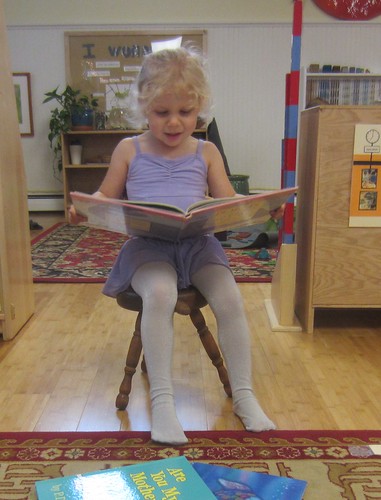



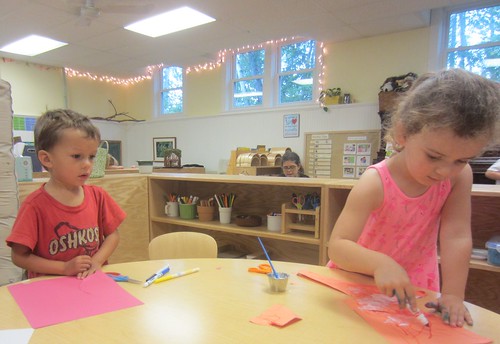

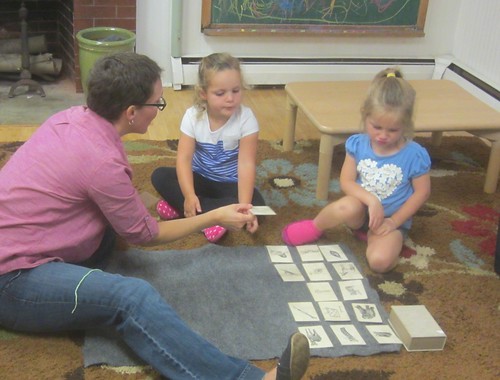




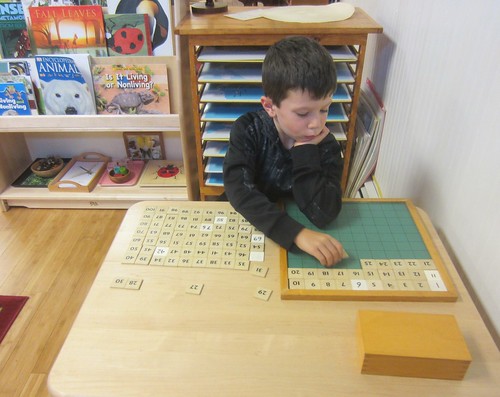








 We have continued to observe our chrysalis, and we read the story The Very Hungry Caterpillar by Eric Carle. We recognized that the author made an error – the story said that the caterpillar built a cocoon and turned into a butterfly, but caterpillars that build cocoons turn into moths, while caterpillars that turn in butterflies transform into chrysalises. We also recognized that the author took creative license when the caterpillar ate all sorts of foods that caterpillars would not eat.
We have continued to observe our chrysalis, and we read the story The Very Hungry Caterpillar by Eric Carle. We recognized that the author made an error – the story said that the caterpillar built a cocoon and turned into a butterfly, but caterpillars that build cocoons turn into moths, while caterpillars that turn in butterflies transform into chrysalises. We also recognized that the author took creative license when the caterpillar ate all sorts of foods that caterpillars would not eat.
We read about and discussed the end of summer and the beginning of Autumn and discussed what would grow in a garden that we may harvest, such as corn, squash, tomatoes, and flowers.
Friendship skills are a necessary skill for forming relationships, particularly ways to initiate an interaction in a positive manner. We read The Very Lonely Firefly by Eric Carle, and introduced six ways to initiate an interaction with a friend: offer a hug, invite to play, give a play idea (ex. “Let’s go build with blocks!”), give a compliment, offer help, and share a toy. We will continue to discuss and work on these skills throughout the year.
After reading Max Found Two Sticks by Brian Pinkney, everyone took a pair of sticks and tapped out some rhythms. Each student took a turn tapping a rhythm for everyone to imitate. We tried some fast beats and slow beats mixed together, some slow beats, and some very fast beats, and listened very closely to follow and repeat.

 Friday students read How Do Apples Grow? and The Apple Pie That Papa Baked, then shared all the things that they KNOW about apples, such as they grow from flowers, they have up to ten seeds, they have five compartments to hold the seeds because the flower has five petals. They then shared the things that they WANT TO KNOW about apples, such as why they grow on trees, and why they fall to the ground. We then did an apple taste test. We observed and described seven varieties of apple, including Gala, Macintosh, Fuji, Granny Smith, Gingergold, Pink Lady, and Honey Crisp. They discovered which were crispy, and which were soft, which were sweet, and which were sour. Most students decided that they liked them all equally, while one was emphatic that he preferred Granny Smith. The children wanted to count all of the seeds in each apple, so they opened them up and figured out how many seeds each held. After tasting our apples we figured out the answers to their questions. They thought then answered their own question about why apples grow on trees using information they read in How Do Apples Grow? – because they are the houses for the seeds. We discussed why we eat apples – because they are full of nutrients, and when they fall to the ground, they make the soil nutrient rich, acting as food for the seeds so they can grow into trees.
Friday students read How Do Apples Grow? and The Apple Pie That Papa Baked, then shared all the things that they KNOW about apples, such as they grow from flowers, they have up to ten seeds, they have five compartments to hold the seeds because the flower has five petals. They then shared the things that they WANT TO KNOW about apples, such as why they grow on trees, and why they fall to the ground. We then did an apple taste test. We observed and described seven varieties of apple, including Gala, Macintosh, Fuji, Granny Smith, Gingergold, Pink Lady, and Honey Crisp. They discovered which were crispy, and which were soft, which were sweet, and which were sour. Most students decided that they liked them all equally, while one was emphatic that he preferred Granny Smith. The children wanted to count all of the seeds in each apple, so they opened them up and figured out how many seeds each held. After tasting our apples we figured out the answers to their questions. They thought then answered their own question about why apples grow on trees using information they read in How Do Apples Grow? – because they are the houses for the seeds. We discussed why we eat apples – because they are full of nutrients, and when they fall to the ground, they make the soil nutrient rich, acting as food for the seeds so they can grow into trees.
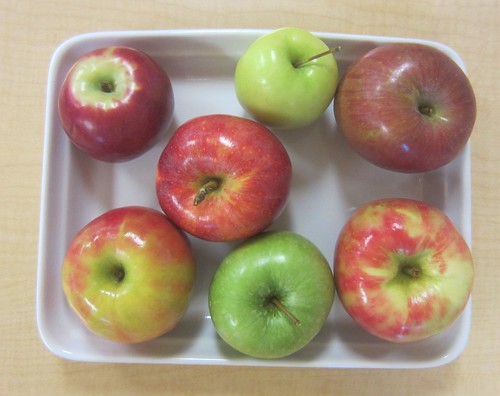




 Some songs we sang this week were “Ladybug’s Picnic,” “Make New Friends,” “Jump Jim Joe,” “The Hokey Pokey,” and “The Ants Go Marching.” Friday students had fun singing “Pig on Her Head” by Laurie Berkner (but with insects), and dancing to “Caterpillar, Caterpillar” by Kira Willey.
Some songs we sang this week were “Ladybug’s Picnic,” “Make New Friends,” “Jump Jim Joe,” “The Hokey Pokey,” and “The Ants Go Marching.” Friday students had fun singing “Pig on Her Head” by Laurie Berkner (but with insects), and dancing to “Caterpillar, Caterpillar” by Kira Willey.




